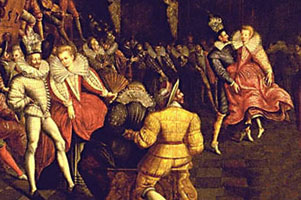A Treasury of Early Music http://www.youtube.com/Searle8
A good example of early music... plus orchestral arrangement...
https://www.youtube.com/watch?v=sxFvM5stEW0&feature=share
Another interpretation
https://www.youtube.com/watch?v=JL22WoJj-Rs
Dances of the Late Renaissance (16th Century)
The two centuries which constitute the Renaissance differed significantly from each other. Music, dance, art, literature, technical innovations, commerce, architecture, city planning and fashions had all made notable advancements by the 16th century.

For the privileged few who had leisure time in the late Renaissance, court life became even more refined, often to extremes. Beneath the courtly manners, however, brewed ruthless political and social intrigue. Courtiers had to continually prove themselves through their social skills, especially through dance. Dance was indeed a pleasure, but it was also much more.
Although dancing was occasionally inserted into theatrical entertainments, Renaissance dance was primarily social — danced for and with one's peers — and was not performed by court nobles in the sense that early ballet was performed by professionals two centuries later. Dance was also a courtship ritual, so dancing skills had to be mastered in one's youth. Marriage age was sometimes as early as twelve, so young men and women of the court had to be accomplished dancers before their teens, often beginning tutored training at the age of six.
In contrast to the two dance forms of 15th century courts, a great variety of dances arose in the 16th century. These included a continued evolution of the ancient peasant Branle (Brawl, Brando), Pavan, Spanish Pavan (Pavaniglia) with its intricate footwork, the virtuoso Galliard (Cinque Passi, Cinq Pas, Sinkapace), Tordion, the risqué Volta, the stamping Canario (Canary), Moresque (Mattachins, sword dances), Alman, Coranto, Gavotte, Torneo, Battaglia and many varieties of the Ballo. Some dances, especially the Balli, were constructed mathematically, to appeal to reason and science, which were regarded as arts. Figures traced on the floor had well understood meanings at the time (triangles, spirals, interlocking rings) so that subtle messages could be conveyed through gestures and patterns. Unfortunately, many of these meanings are lost today.

Regional dances were diffused throughout Europe by arranged political marriages and their attendant multicultural festivities. Dances were also exchanged between the courts and countryside: aristocratic dances "sank" into the lower classes over time, much as clothes were handed down as they wore out, and at the same time some of the more interesting peasant Branles, observed in the countryside, were brought into the courts.
As in the 15th century, the favored dance masters were usually Italian. Although the balance of political and commercial power was shifting to England, France and Spain, these courts still preferred to dance in the Italian style. Italian dance had the same prestige in the 16th century that French court dance had in the Baroque era. Dance instruction books continued to be written by professional dance masters (usually Italian) and for the first time were reproduced and distributed widely, due to the advancement of printing methods. Fabritio Caroso of Sermonetta (near Rome) and Cesare Negri of Milan wrote detailed and comprehensive dance manuals, while Livio Lupi of Palermo wrote specialized handbooks on the galliard.

As in the previous century, most surviving dance treatises described the court activities of the aristocracy. An important exception was Orchesography, written by the French cleric Jehan Tabouret (writing under the anagram Thoinot Arbeau). Arbeau was the first to describe the peasant Branles, complete with music, as well as rare descriptions of La Volta, Alman, Gavotte, a 16th century Basse Dance, Coranto, Tordion and the sword dance Buffens.
Music evolved into its next form at the turn of the next century, around 1610, most notably with the compositions of Claudio Monteverdi (1567-1643) which are considered Early Baroque. However dance was slower to change, with the late Renaissance dance forms continuing to about 1625 (or 1650 in the nether regions) until they eventually faded from popularity.
— Richard Powers



No comments:
Post a Comment